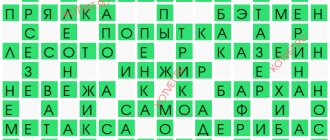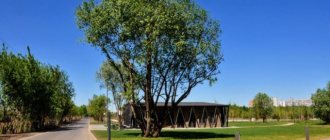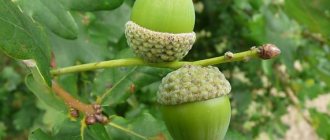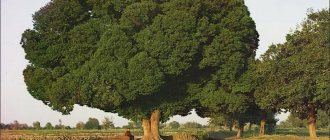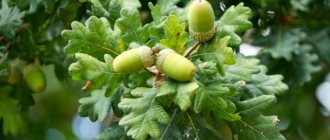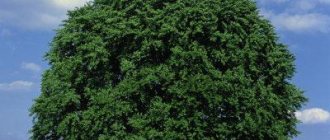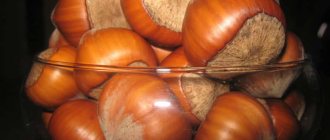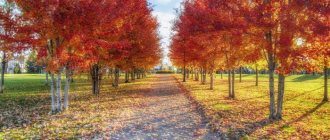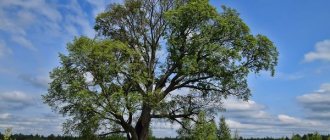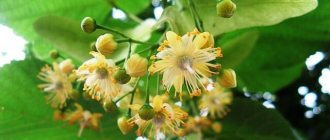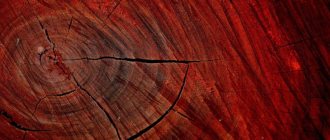Description of the genus
Elm (from Latin ulmus laevis) is compared to oak in its majesty and power. This is a relict species, the lifespan of which trees goes back several centuries. The growing area of elm species is extensive; in Russia they are found in several subspecies; in addition, they can be seen in North America and Europe.
This genus of trees is found both as single representatives and in mixed plantings. They also feel quite good in poor soils, but mostly grow on fertile lands. This type of tree grows upward even when there is not enough sun. At the same time, the growth rate of elm is very high. The growth per year is about 50 cm in height, and in trunk girth up to 0.3 meters.
A mature elm can reach 40 meters, but there are also species that resemble shrubs. The surface of the bark of a young elm is without roughness, light brown in color, and over time it becomes covered with vertical grooves. The root system of the tree is powerful, the roots penetrate to a depth of 30 meters with a trunk with a girth of 1.5 meters. But some species have their roots spread out rather than deep, covering vast areas.
Elm leaves differ significantly from other species in their elongated oval shape and jagged edges. Leaf size is from 4 to 20 centimeters. They are located alternately on the branches and are attached to them with short cuttings. In autumn they change color from green to red-brown and the crown quickly thins out.
The tree blooms in the spring, before it becomes overgrown with leaves. The inflorescences are small, yellow in color. Elm seeds are small winged nuts. They ripen in the last days of May, and the wind scatters them throughout the surrounding area. If the conditions are right, they can germinate within a few days.
Price of elm tree
For the middle zone, the elm tree is a rare occurrence. To buy an elm tree you need to try, since its seedlings are practically not sold in nurseries of coniferous and deciduous trees.
It needs suitable climatic conditions; harsh Russian winters and rainy summers do not have a favorable effect on this ancient tree, with the strange and mystical name elm.
The price of the elm tree , or rather its seedling, has not actually been established. It can be brought from the regions of its main growth or put out from seeds. Elm does not produce basal shoots.
However, it should be noted that its main purpose is landscaping parks. Due to the spreading crown, which provides great shade and the giant root system, it is not recommended to plant such a tree near the house.
Types of elms
Elm is the most common species of elm. It easily adapts to negative weather conditions and tolerates temperatures down to -28 °C. Popular tree subspecies include:
- The elm is smooth, stretches up to a height of 25 meters, the table is covered with bark with a pronounced relief, of a dark brown hue. The leaves are large. Elm differs from other varieties in the shade of its foliage; it is dark green on one side and light on the other, covered with a light fluff. The flowers of this tree are purple with a hint of burgundy.
- The squat elm, living up to its name, is small in size. It reaches a height of up to 15 meters and often looks like a bush. Most often found in the Far Eastern region. The leaves are small, soft green in color. Inflorescences are yellow-brown, small.
- Rough elm. Grows in rich soils. Most often found in mixed forests. The trunk is covered with smoother bark than other species. Reaches 40 meters. The foliage is large, green, with an uneven surface.
Planting and care
Planting elm in the local area is not difficult. You will need ripe, dried seeds. Shoots appear a few days after immersion in the ground. It is important to remember that germination quickly disappears, so it is important not to waste time. Elm fruits should be planted according to the following algorithm:
- It is necessary to collect the seeds after flowering has completed. After this, they are placed in nutrient soil or wet cotton wool. It is advisable to pre-treat the fruits with anti-fungal agents.
- After a few days, the seeds are planted in a container with soil. The best choice in this situation would be black soil, as this will increase the growth rate. But humus with leaves will also work. Be sure to choose a soil that is soft and sufficiently moist.
- The seeds are immersed to a depth of 1-2 cm, the distance between the holes should be approximately 25 cm. The ground is covered with moss, dry grass or cotton wool. The soil is moistened every day. After 10 days, you can see the young elm and remove the covering material.
It is advisable to frequently place the sprouts in the sun. In the absence of precipitation and wind, it is good to leave the container with young sprouts on the balcony or in the garden in the air. During the first year, the plant reaches 20 cm. The seedling can be planted in the ground in the second year.
In the first years, elm must be protected from excessive wind and low temperatures. For the winter, the tree must be covered with special material. It is important to remember that soil saturation affects how roots form, so poor soil needs to be fertilized. It is also important to regularly loosen the soil around the shoot.
Over the course of a year, the elm grows 40-50 cm in height. The branches are not pruned for 1-2 years; the crown is required to form. Only diseased or dry branches should be removed. It is permissible to trim the crown while the seedling is growing.
Collection (procurement) of raw materials
The optimal period for harvesting elm bark, removed from young branches, is the last ten days of March and the beginning of April.
If necessary, cut the raw materials into small fragments and scatter them on racks in a well-ventilated barn or under a canopy. You can dry the dried pieces in the oven at 50 degrees. It is more convenient to use special dryers.
Dry weather is selected for cutting leaves in May-June. It is advisable to harvest in the afternoon, when droplets of morning moisture completely disappear on the leaves, and the sun bakes less intensely.
For drying, select a place in the shade, where the leaves are poured onto thick white paper in a thin layer. Raw materials should be stirred periodically.
Dried leaves and bark are poured into linen bags or wooden boxes with holes. They are stored for about two years.
Diseases and pests
Typically, elm is affected by elm springtail, scale insects, and leaf beetles. It is easy to identify a disease in a tree; its crown dries out and growths appear on the bark. To combat parasites, treatment with liquid copper sulfate, insecticides and fungicides is used.
Young trees are easier to get rid of diseases. Old elms are difficult to get rid of parasites, especially fungi. That is why the use of antifungal agents is recommended at the planting stage.
Meaning and Application
It is difficult to overestimate the importance of elm. Its bark, fruits and leaves are successfully used in folk medicinal recipes. It is important to talk to your healthcare professional before using elm in the treatment of various diseases. Therapy has side effects and contraindications.
Decoctions based on bark and leaves help reduce inflammation, have antibacterial properties, and help heal damage. The extract is used for the treatment of kidney, heart, blood vessels, thyroid gland, etc.
A decoction is useful for throat diseases. So, if you have a sore throat, it is recommended to gargle with it. Tea from the leaves is used for constipation. In case of hemorrhoids and kidney diseases, baths with elm bark are recommended. The tincture is used to get rid of skin rashes.
Elm wood is often used in industrial production due to its excellent properties. Elm wood is often used as an alternative to expensive wood species. Its texture allows you to imitate valuable varieties, with a fairly light color. Mahogany connoisseurs love elm. Elm is used to make furniture for the home and is also used to make paintings.
The density of elm wood is very high, approximately 600 kg/m3. The cut of wood has a beautiful texture, which makes it suitable for use in carpentry. It is resistant to rotting processes and is difficult to split and saw. However, it behaves very well when polished.
In the old days, elm was also used in carpentry workshops, and paint was made from its bark. Without taking into account the pests that attack the tree, it is often planted in parks, around the city, and in social institutions.
Bark tea
For various pathological conditions, healing tea is prepared from elm raw materials at home, adhering to proven methods.
- For diarrhea
Crushed elm bark - 3 tsp. pour into an enamel saucepan. Pour in cool water - 250 ml. Place on the stove and bring the liquid to a boil. Remove the dishes, cool the tea until warm and strain.
Drink the resulting volume once a day. This drink relieves inflammation, which is why it is used as a gargle to treat sore throat. You can apply lotions to wounds.
- For arthritis
Place small pieces of dried peel - 10 g in a faience glass. Brew with freshly boiled water - 200 ml. Leave under a warm scarf until cool.
After filtering, drink 50 ml of healing tea every 8 hours between meals.
Use in landscape design
The elm looks like a mighty, strong tree with a dome-shaped crown. It is the dense foliage that allows it to be used as a barrier against dust, gases, and dirty air for residential areas. Moreover, in addition to such an important practical function, elm forms a beautiful, green landscape.
The crown of elms is often used to create shapes in landscape designs. The density of the branches allows you to cut a wide variety of shapes. Powerful, strong roots of the tree can strengthen the banks of lakes, rivers, and the slopes of ravines. Thus, planting elm, in addition to its decorative function, will fulfill an important, practical role.
Elm is an excellent solution for a personal garden. In addition to the obvious landscaping, it will strengthen the soil. Thanks to this, fertile soils will not slide and will be preserved from weathering and erosion.
When deciding to plant elms, it is important to take into account their subspecies and dimensions. Since the diversity of elm is great, there are both miniature and huge specimens.
So, a tall, spreading tree is not suitable for a small area. And over a large area there will not be enough bushes.
Contraindications
No serious contraindications to medicinal forms from elm bark or foliage have been identified.
Do not take if you are intolerant to such drugs. Do not use if you are prone to thrombosis. They cannot be treated during lactation and pregnancy.
To avoid negative consequences and prevent harm to health, do not exceed the ratios specified in the recipes. If nausea, sudden dizziness, or intestinal disorders occur, the therapeutic use of home remedies should be stopped immediately.
Thanks to elm raw materials in the form of dried or freshly picked leaves, pieces of bark, it is possible to independently prepare a variety of healing remedies.
With proper selection of techniques, the treatment of certain diseases is activated. It is important to consult a doctor to determine the dosage and duration of use.
